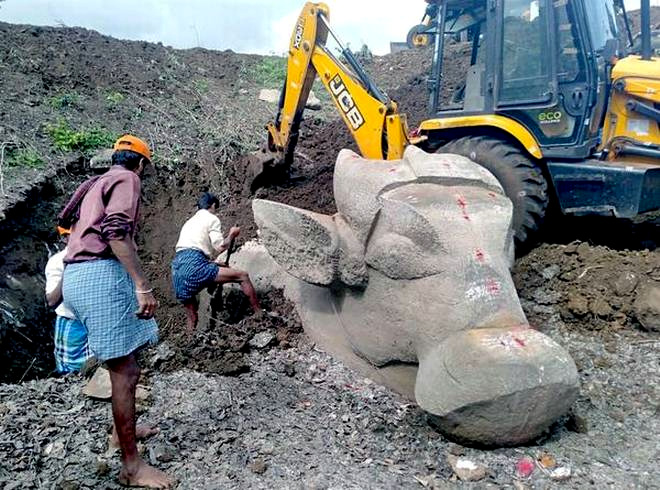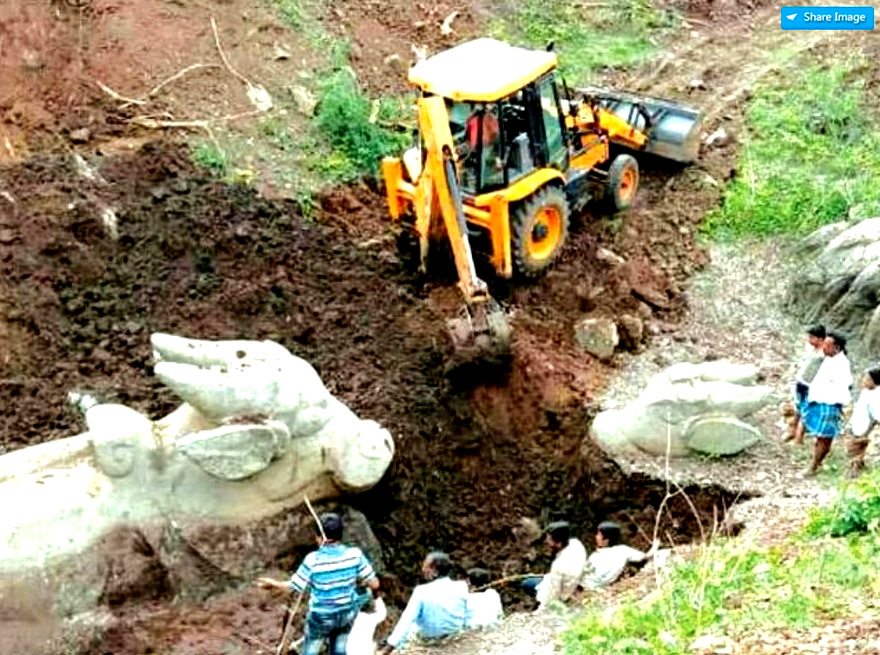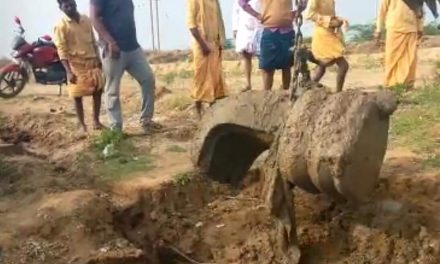A pair of centuries-old Nandi statues, carved out of monolithic soapstone, have been unearthed from a dried lake bed in Arasinakere, about 20 km from Mysore.
The locals, who dug up the area and even deployed an earth mover during a three-to-four-day exercise, managed to unearth two giant Nandi statues facing each other.
A team of officials from the Department of Archaeology, Museums and Heritage, including archaeologist M.L. Gowda and engineer Satish, visited the spot on Monday. Mr. Gowda said the statues appeared to belong to the 16th or 17th century, dating back to the post-Vijayanagar period. He said they resembled most of the sculptures carved out of the smooth soapstone during that period.
The statues are carved out of a single rock. “The statues are incomplete. While one appears to be 60% completed, the other is at about 85%,” Mr. Gowda said. He added that the statues were also not identical in size. While the larger one is around 15 feet in length and 12 feet in height, the smaller one is more compact, according to locals.
The locals, particularly the senior citizens of the village, had earlier been aware of the presence of the Nandis, whose heads appeared to peep out partially whenever the water level in the lake dipped. The complete drying up of the water body during summer presented the curious residents an opportunity to dig deeper.
Report sent
A report on the excavation has been sent to the Commissioner of the Department Archaeology, Museums and Heritage, T. Venkatesh. For the time being, further excavation has been stopped and the department officials is awaiting instructions from seniors on the measures to be taken for the statues’ conservation. Mr. Gowda said the department had been aware of the presence of the statues. “We conducted a spot inspection during 2016, but the area was covered with shrubs and submerged,” he said.
Meanwhile, citing locals, Jyothi S., Panchayat Development Officer of Marballi Gram Panchayat, under whose purview Arasinakere falls, said the village adjoining the water body is named after the Maharaja. Arasinakere, when translated into English, means ‘the king’s lake’, she said.
Locals also claim that the late Maharaja of Mysore, Sri Jayachamarajendra Wadiyar, had visited the lake several decades ago and tried to unearth the statues by deploying men and material. However, the labourers had to be abandon the task because of the rising water level in the lake.
While the locals suggest there could be an ancient temple beneath the lake, archaeologists say it is plausible that the Nandi statues had been carved out of the rock found at the spot for transportation to a different destination.














Just surprising and gives a glimpse of mysteries our land still holds.
I do believe there’s Lord Shivā’s abode beneath or around it..
To be noted is, they’re facing at each other…. What signal is that?
There appears to be our own lethargic attempts by the archaeological depts. All advanced facilities are a waste for this dept. Thank god they may not have sent the message by a horse bound messenger.
Instead of wasting the time they could have taken few photos and sent them with the text through WhatsApp to their higher ups who could have given the reply in an hour by the same way, so that further excavation could have continued and the decision would have been concluded with a solution for further actions.
Perhaps they are waiting for someone to do the job and send it / sell that to someone!
Great finding and further investigation may lead to the presence of a temple.
another proof that shows that Lord Shiva’s cult was the original and most ancient deity and culture of south india.
Great finds show our heritage of Hinduism has deep roots . .
Thank you.
It shows and proves how elite and rajas and maharajas encouraged the Art, our Hindu heritage and Indian culture. Did they expect any reward for their services? That is their greatness. Will present generation learn from past? A Million dollar question. Episode and untoward happening at Nava Brindavana is an eye-opener.
The Hindu Caribbean welcomes this news about our heritage whenever and wherever it is being unearthed. We Hindus are classified as Pagans and treated accordingly. Thi prejudice operating in modern colonial systems continue th hold institutional prejudices, no wonder, even in BHARAT there is a sluggish response to these things.
Raviji Trinidad